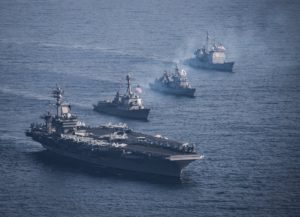Just how powerful is Pres. Trump’s ‘armada’?

[Originally published at Canada Free Press]
“We are sending an armada.”
Pres. Donald J. Trump’s declaration during a television interview on the Fox Business Channel signaled the deployment of Carrier Strike Group One to the Korean Peninsula in response to North Korea’s bellicose rhetoric and upcoming missile test. The Navy canceled a series of port calls for the strike group earlier this month and diverted the ships to the Korean Peninsula in a show of force against the hermit kingdom.
But what’s in the armada?
Carrier Strike Group One centers around USS Carl Vinson (CVN 70), one of the United States’ 10 aircraft carriers. Accompanying the flagship are Arleigh Burke-class guided-missile destroyers USS Michael Murphy (DDG 112) and USS Wayne E. Meyer (DDG 108), along with the Ticonderoga-class guided-missile cruiser USS Lake Champlain (CG 57). Although typically unreported, a submarine presence also sails with the strike group.
The surface vessels carry hundreds of Tomahawk cruise missiles, each capable of accurately hitting land targets 1,000 miles away, and Lake Champlain carries Harpoon missiles that can destroy enemy ships over 60 miles away. The 5-in. guns on the destroyers and cruiser can fire a 70-lb. projectile up to 13 nautical miles away at a rate of 16-20 rounds per minute. For defense, each surface ship in the strike group carries multiple Phalanx 20mm radar-controlled cannons that fire 75 rounds a second and can intercept incoming anti-ship missiles over two miles away. The Vinson carries multiple surface-to-air missile launchers to protect against enemy aircraft.
Around 100 aircraft, both fixed wing and helicopters, operate off the decks of Carl Vinson. Four fighter squadrons: The “Bounty Hunters” of Strike Fighter Squadron 2 (VFA-2) operating the two-seat F/A-18F; the “Blue Blasters” of VFA-34, flying the F/A-18C; and the “Kestrels” of VFA-137 and “Golden Dragons” of VFA-192, each flying the F/A-18E. The C-model “Hornets” can carry 15,000 lbs. of ordinance, both air-to-air and air-to-ground conventional and guided munitions, with a combat radius of 290 nautical miles. The larger E- and F-model “Super Hornets” can carry 17,000 lbs. of ordinance with a combat radius of 390 nautical miles. The fighter/attack aircraft can handle a multitude of roles: air superiority, fighter escort, suppression of enemy air defenses (“Wild Weasel” missions), reconnaissance, forward air control, close/deep air support, and day/night strike missions.
The “Gauntlets” of Electronic Attack Squadron 136 (VAQ-136) can jam enemy radars, hiding the radar signature of friendly attack aircraft. The two-seat EA-18G “Growler” is also capable of locating and destroying enemy communication or radar-emitting sources.
Vinson’s E-2C Hawkeye aircraft of Carrier Air Wing Early Warning Squadron 113 (VAW-113) “Black Eagles” provide the group with airborne early warning capabilities. The 24-ft radome above the Hawkeye’s fuselage houses a rotating antenna with sensors that can locate and identify surface (land or sea) and airborne targets, such as enemy aircraft and missiles up to 200 miles away. The five-man Hawkeye crew can also conduct surveillance, relay communications, and perform command and control of missions such as strikes and rescues.
Carl Vinson is home to two helicopter squadrons: the “Black Knights” of Helicopter Sea Combat Squadron 4, flying the MH-60S “Knighthawk,” and the “Blue Hawks” of Helicopter Maritime Strike Squadron 78, flying MH-60R “Seahawks.” The helicopters provide the fleet with anti-surface and anti-submarine warfare capabilities, search and rescue, combat search and rescue, special operations support and logistics, and naval surface fire support. The choppers can carry torpedoes and Hellfire air-to-ground missiles.
Carl Vinson is reportedly within striking range of North Korea. Two guided missile destroyers are already operating in the hermit kingdom’s back yard: Wayne E. Meyer has been conducting drills with the South Korean navy. Another destroyer, USS Fitzgerald (DDG-62), is conducting drills with the Japanese. The Ohio-class guided missile submarine USS Michigan (SSGN-727), a nuclear submarine carrying over 150 Tomahawk cruise missiles and capable of delivering special operations forces, sits off the coast of South Korea.
Two Japanese destroyers sail with the Vinson Strike Group and additional South Korean ships will reportedly join the armada.
North Korean state propaganda claims they intend sink the Vinson. While reports indicate that the ships of the Carl Vinson Strike Group do not carry missiles capable of intercepting North Korean ballistic missiles, the Pentagon confirms that the Navy has the capacity to protect against a North Korean missile strike against the fleet, should the need arise.
“The weapons that North Korea would put against the Carl Vinson strike group are easily defended by the capabilities resident in that strike group,” Adm. Henry Harris told the House Armed Service Committee on Wednesday. “If it flies, it will die.”
North Korea does not currently possess anti-ship ballistic missiles capable of targeting the strike group. However, five destroyers from the Pacific Fleet, carrying the advanced Aegis ballistic missile defense system, are reportedly operating in the area (the U.S. Seventh Fleet, headquartered in Japan, consists of dozens of ships and hundreds of aircraft). The Aegis’ SM-3 missile, capable of intercepting short- to intermediate-range missiles, has a range of 378 miles and recent tests demonstrate that the missile can even knock out satellites.
Only time will tell if the Trump Administration’s toughened stance against North Korea will end the communist nation’s belligerence. However, launching 59 cruise missiles at a Syrian airbase and dropping the “Mother of All Bombs” in Afghanistan signaled America’s enemies that the Obama era of soft power, leading from behind, and easily overstepped red lines is over. The presence of a heavily-armed carrier strike group sitting off the shores of North Korea is indeed, as the president said, “Very powerful.”